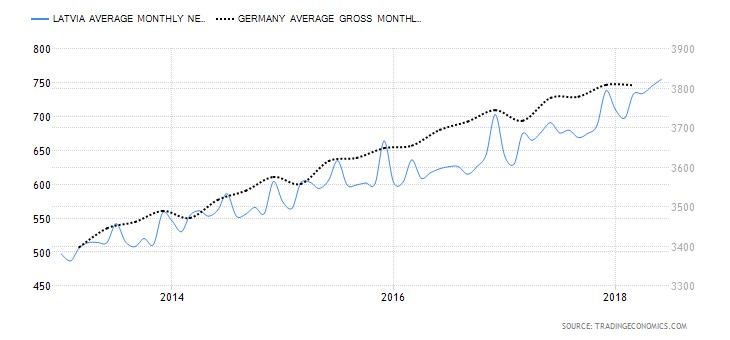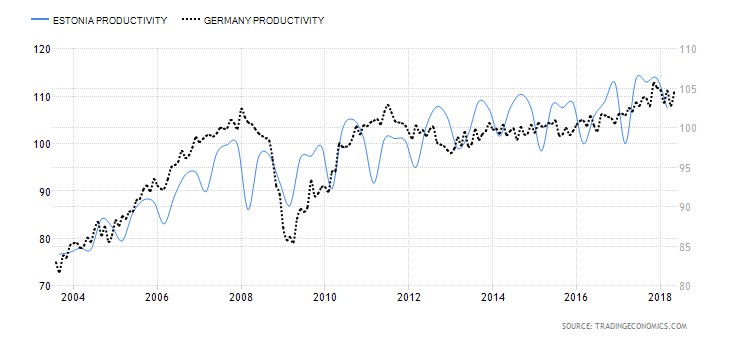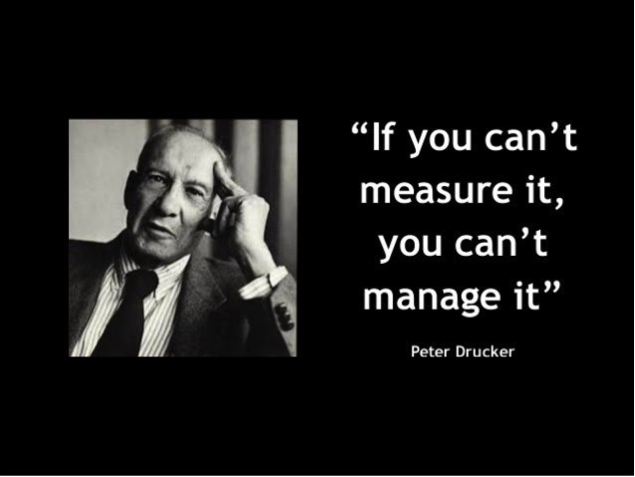Low productivity, lack of workforce and how to deal with it
Low productivity, lack of workforce and how to fix it
I remember it quite vividly – about 15 years ago, when I was a junior management consultant and our country was about to join EU, the hot topic was productivity. Latvians were making almost 2 times less than Germans and other “westerners” and were afraid that price hike following joining the EU and eurozone will supersede the salary growth.

I realize that this is a comparison between gross and net wages, but the trend is what is important here
Common perception has been that Baltic countries were lagging horribly behind in employee per capita productivity, compared to Western countries. This fact was held single-handedly responsible for lower wages across all sectors of economy. And since there has been no obvious solution, we just stopped talking about it.
Fast forward to today and the salary difference has increased to become even larger and don’t get me started on purchasing power. Productivity difference between two countries, however, has remained on par (in relative terms).

A more significant change though is that our new hot topic tois “We are desperately short on hands”.
The reason I bring these up is quite simple: our current “there are no available people in the market” problem is not the real issue in many cases. It’s the same issue we saw 15 years ago: Latvian companies are quite poor at managing productivity and did not manage to make the leap required to bring our income to the level of our European neighbours. In fact, it is quite possible that we have become even less productive than before, which may explain an even larger gap between Latvian and German wages. There are exceptions of course, but number of these efficient companies could and should be much higher.
If you can’t measure it, you can’t manage it
Management of human resources is a very complex process, due to human nature. This is why, most companies end up settling for the good old “we have always done it this way” approach, when it comes to attendance & time management.
Ever since the installation of first punch-in time clock devices in factories, there has been little to no innovation. This means that despite all modern possibilities, company managers blankly stare at the number of attendance hours and do so little to find a way to improve what is being done. This might be one of the greatest differentiators between Latvian and German businesses. German manager knows that every single employee worked 160 hours this month, Latvian one – assumes that this was the case.
Also, German companies have been steadily increasing their investment into modern HR tech over the past decade, while most Latvian ones have been quite sheepish in this area.
Essentially, many companies don’t improve, manage and innovate their employee performance and productivity, simply because they don’t measure it correctly or at all.

This is the “simple” explanation – most Latvian companies measure employee working time “approximately”. E.g. if there are 176 working hours in a month and employee showed up at work, then it is assumed that he worked 8 hours each day. When in fact, he or she might’ve been late 20 minutes every day and left 10 minutes earlier. Consider this math:
0,5 hours * 250 working days a year * 10 eur/hour employee costs = 1250 euro lost on a single employee per year.
The employee might not even realize that this is happening, but neither is the employer, unless they measure working time. But what if it’s 10s, 100s, 1000s of employees?
What makes work time measurement so difficult?
Like most other easily expendable resources, time is prone to just slipping, going unnoticed or being misrepresented.
Some of the most common problems with time management, which, unfortunately, are being wildly accepted, include, but are not limited to:
· Precise measurement of employee work starting and ending
· Tracking actual time spent on operations/projects
· Comparing planned time expenditures with actual values
· Cheating and misrepresenting attendance data
Most of these are difficult to measure, because of required managerial time. It feels like we are wasting time on measuring how much time we might be wasting. Many companies just give up and let the time flow, hoping that “we are mostly efficient, who cares about minutes”. This mentality is what keeps us from making the real productivity leap to catch up with the West.
There are good news though: modern time tracking technology can alleviate the pain of managing employee time by A LOT. Also, it’s no longer hugely expensive and reserved for large companies (and Germans).
The solution to employee time measurement is… ?
It sounds obvious, but our society has evolved, and individuals have become more technologically advanced. 15 years ago, there were plenty of people, especially baby-boomers and older generations that had 0 computer literacy. This, in turn, meant that large part of workforce was effectively afraid of operating computers and other electronic devices.
Today, fortunately, this is almost entirely no longer the case. Large part of capable workforce is using smartphones and online banking. This means that they are quite capable to use more advanced tools at their work. And this includes recording their working time.
Businesses today can and should entrust worktime measurement to employees. The analysis and improvement will likely still be done by managers, but it is the employees timing themselves, which is the solution to current inability to accurately measure working time.
Before we move on to the technological marvels enabling this, it’s worth pointing out that there are two very distinctive paradigms for employee time management.
Liberal VS conservative
Disclaimer: both schools of thought are valid and have benefits, as well as flaws. Which one to use for which individual employee or position is a matter of practicality.
“We don’t care where, when and how you do your job, as long as the results are there on time”
The typical liberal way of looking at employee time. This doesn’t mean that employers are abandoning time measurement entirely. They just have the luxury or strategy to measure working time in larger blocks. Rather than looking at minutes and hours, they look at weekly or even monthly productivity.
“Every minute counts”
Is the more conservative approach. Customer facing positions need real people to be there. Complex tasks, which require physical interoperability also require teams to be in perfect time sync for optimal results. Crane operator being late may force 10 others to wait, alongside the rented crane and other machinery.
Both approaches benefit greatly from technological advances, available for measuring working time. As do they require a trustful and loyal relationship between company and employee. If there is no trust and mutual loyalty, then no amount of measurement will help you get to 100% efficiency.

Measuring time in the 21st Century
The single most important advance of modern time registration technology is the ability to register not just the time, but operation, project and other dimensions of employee activity. This solves one of the main pain points of old inefficient time management: What good is knowing that someone was spending time at work, without knowing exactly what they were doing?
This kind of information helps companies improve internal processes and routines, optimize schedules and get closer to real activity-based costing. Which leads to reduced costs and increased profits.
Another technological novelty is replacement of traditional mechanical punch-in devices (papers, excels etc) with biometric terminals, which use finger prints or eye iris for identification. These used to be rather expensive and reserved for government facilities, banks and Hollywood, but are quite available nowadays.
Biometric terminals bring two distinct advantages to time measurement:
1. They are a great anti-cheating tool. As we all know, in certain cases, employees are prone to cheating employers with clock-in, clock-out and break times. 99% of employees wouldn’t go as far as faking their fingerprints or iris.
2. They provide an added security measure, if also used as an access verification mechanism. A simple magnetic lock connected to a biometric terminal can help a company make their hallways a mini Fort Knox.
It is worth pointing out that new European General Data Protection Regulation (GDPR) considers biometric data “special”. Which means that employers should be extra careful, if they are in fact processing (gathering, storing, using) biometric data of employees.
Employers of mobile and/or remote work force can benefit greatly from mobile time tracking applications. These function as a work registration terminal on the go and benefit both the liberal and conservative approaches regardless of industry, be it carpet cleaning or construction.
Mobile interfaces provide a plethora of options for employees to enter information about their activities. Since most smartphones are online, managers of such employees get information in real-time.
Smartphones also come equipped with GPS functionality, meaning that employers may gain an extra insight on employee’s location at work.
A slightly more advanced feature of mobile applications is the geofencing technology. A virtual perimeter is created around a “workplace” and once an employee crosses the invisible line (with designated smart phone in their pocket) they are clocked-in or clocked-out automatically.
This used to be rather expensive and often required complex programming, additional equipment and was an absolute killer to batteries of mobile phones. Fortunately now, it is something many employers can benefit from. Quite soon, time tracking and planning will be made fully automatic and geofencing is likely going to be a part of this new age time management setup.
Last, but not least, the actual analysis of attendance data (which still needs to be collected) has become much easier. Time management systems are offering interfaces for connecting them to databases full of other useful numbers. Meaning that even relatively small employers can enrich their operational data with employee worktime information for decision-making and all kinds of improvements. For example:
· Retailers can combine scheduling data with customer purchase data to improve service quality
· Construction can combine project deadline data with individual employee skills speeds to optimize staffing across multiple projects
· Manufacturing companies can combine manufacturing recipe data with attendance data to create optimal shifts for various orders
· Service companies can use absence data in combination with skill data to create perfect teams
I’m sure you can think of a million things, which can be done with properly measured employee time tracking data. Just remember: If you can’t measure it, you can’t improve it.
There are plenty of ways to start measuring employee time in an easy and efficient way. If all companies apply this approach, we might see a spike in our productivity, making our society better and richer.
